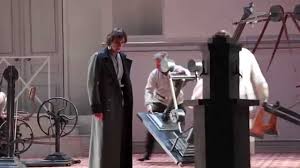Fathom events, April – On Sunday, April 9, 2017, live from Moscow, thousands of movie-goers throughout the United States and abroad were treated to a one-time cinema viewing of A Hero of Our Time, the final ballet of the Bolshoi’s 2016-2017 Season. The splendid production was presented by Fathom Events, the indispensable conduit of cultural treasures with worldwide distribution and production by Pathé Live.
The ballet in three acts was choreographed by Yuri Possokhov with music by Ilya Demutsky and is based on a novel made up of five novellas by Mikhail Lermontov (1814-1841), a Russian writer and poet considered to be second only to Pushkin. Lermontov’s so-called “Superfluous man” novel features a classic Byronic hero (or anti-hero) by the name of Pechorin who in the ballet adaptation is represented by three different dancers in each of three act. (Vladimir Nabacov rendered English translation of the novel in 1958.) The three novellas adapted from the novel were “Bela,” “Taman,” and the longest of the short stories, “Princess Mary.”
The ballet is superb in all its manifestations on the Bolshoi’s wonderful new stage. The choreography is strong, crisp, and innovative and each of the three acts stand alone in style and tone from each other. However, therein lies a potential problem for an audience unfamiliar with Lermontov’s collection of novellas. The main source of potential confusion is the fact that the protagonist, Pecheron, is performed by three different dancers in each of the three acts: Act one features Igor Tsvirko, act two is danced by Artem Ovacharenko, and act three performed by Ruslan Skvortsov, all wonderfully powerful, precision dancers in the grand tradition of the incomparable Bolshoi.
The three acts have a continuity of character portrayal (Pecheron), but differ markedly in style and tone which may add to possible confusion. Each of the three interpretations of Pecheron shows a side of his character which is influenced by age and experience. In “Bela” he appears indifferent to Bela, danced by Olga Smirnova, but is remorseful in a solo performance after her death. In “Taman,” so name for a small coastal town by the Black Sea, is home to a group of shady smugglers whom our hero gets involved with. Fearing that Pecheron will alert the authorities of their nefarious activitiea, a young woman named Undine, danced with purposeful strength by Eketertina Shipulina, attempts to drown him. Escaping, he winds up in a spa town for rehabilitating army officers. Pecheron flirts with Princess Mary , performed by Svetlana Zakharova, who falls in love with him, but he was merely toying with her affections and has no romantic interest in her. He is challenged to a duel by her frustrated boyfriend whom he kills. He ultimately loses his true love Vera, danced by Kristina Kretova, and lives on in despair as a matured and self-reflective “hero.”
The male dancers of course are as strong as usual, but it’s the ballerinas who shine in this production. Olga Smirnov as Bela is convincing as a young innocent woman who is given to Pecheron in exchange for a horse. As act one opens, she is covered in a blanket and is both vulnerable and mysterious. Her dancing is fluid and alluring beautiful. Ekaterina Shipulina appears as the femme fatale Undine in act two, a passionate red-swan-like force, danced with strength and conviction. The graceful Svetina Zakhaorova performs the naive Princess Mary with style and grace, and as Pecheron’s only true love, Kristina Kretova’s Vera performs a dark and melodramatic solo that stands out as one of the most profoundly emotional and memorable moments in the ballet.
Atmosphere is very important in the novel and in this production itself and is well-expressed in the modern stage sets and Ilya Demusky’s varied and haunting score. Each act opens with a solo performance accompanied on stage by a solo musician or opera singer which has a haunting impact. Russian folk influences are apparent in Caucasus of act one. Act two the set designer (uncredited in the cinema info sheet) create hints of a small, harsh village represented by construction-like scaffolding and an ominous chorus of smugglers with flashlights. The third act takes place in a kind of gymnasium which simultaneously serves as a ballet studio, gym, hall, and medical clinic/hospital, a somewhat disconcerting and confusing series of locals which in their own way add to the intriguing and unexpected nature of this extraordinary and eminently memorable ballet.
by Lidia Paulinska and Hugh McMahon
